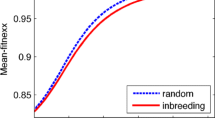Summary
The progress of inbreeding is considered where more than two allelomorphs are concerned. This increases the time needed to attain a given degree of homozygosis by about a generation. The time taken to reach a given degree of purity (i.e. the condition where mates are like homozygotes) is from one to two generations longer than that needed to reach the same degree of homozygosis.
Similar content being viewed by others
References
Haldane, J. B. S. (1936). “The amount of heterozygosis to be expected in an approximately pure line.”J. Genet. 32, 375–91.
Robbins, R. B. (1917). “Some applications of mathematics to breeding problems.”Genetics,2, 489–504.
Schäfer, W. (1936). “Über die Zunahme der Isozygotie (Gleicherbigkeit) bei fortgesetzten Brüder-Schwester-Inzucht.”Z. indukt. Abstamm.- u. VererbLehre,72, 50–79.
Rights and permissions
About this article
Cite this article
Haldane, J.B.S. Some theoretical results of continued brother-sister mating. Journ. of Genetics 34, 265–274 (1937). https://doi.org/10.1007/BF02982267
Issue Date:
DOI: https://doi.org/10.1007/BF02982267




